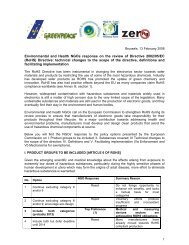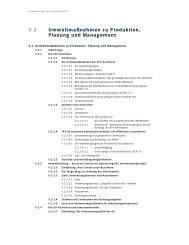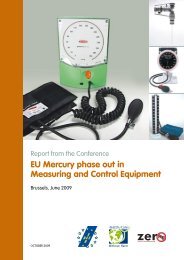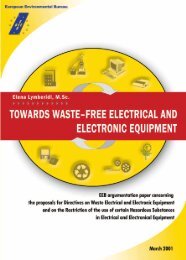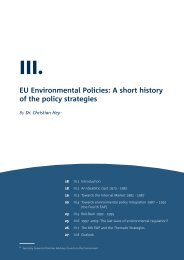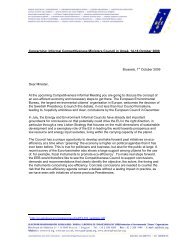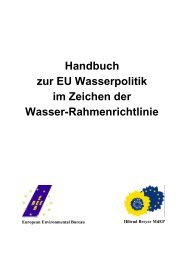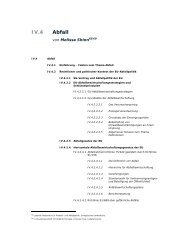EMAS III - European Environmental Citizens Organisation for ...
EMAS III - European Environmental Citizens Organisation for ...
EMAS III - European Environmental Citizens Organisation for ...
You also want an ePaper? Increase the reach of your titles
YUMPU automatically turns print PDFs into web optimized ePapers that Google loves.
different. For instance, some companies produce textiles whilst others only trade in them, not<br />
to mention the number of mixed approaches in between. The level of outsourcing of stages<br />
of production can differ significantly between enterprises.<br />
By relating the environmental impacts to turnover or value added the environmental balance<br />
may even be distorted. A producer of luxury cars with a high (added) value will have a<br />
comparatively good ecological record compared to a producer of cheaper cars, wrongly<br />
suggesting a better environmental per<strong>for</strong>mance of the <strong>for</strong>mer (a higher denominator means a<br />
lower value).<br />
Moreover, the direct indicators may be irrelevant compared to impacts in other life cycle<br />
stages. Staying with the car example – the burdens associated with the assembly of cars are<br />
just a minor fraction of the overall impacts. Much more relevant are the production of raw<br />
materials (e.g. steel) and, in particular, the use of the cars (petrol consumption). So <strong>for</strong> the<br />
cars industry the relevant energy indicator is not the annual “total direct energy use” divided<br />
by the gross value added, but the average fleet consumption.<br />
Also, in our view the Commission proposal lacks clarity regarding the details of the energy<br />
and material flows to be included. For instance, it is not clear which materials should be<br />
recorded at which level of precision using which methods? Without clear-cut rules <strong>for</strong> this the<br />
indicator results are unlikely to be more than arbitrary figures.<br />
The numerous problems associated with the development of meaningful comparable<br />
indicators were investigated in a study published by the Consumer Council at the Austrian<br />
Standards Institute 13 in 2008. A major conclusion was that such indicators can only be<br />
derived at a (sub) sector level focusing on processes or products (e.g. energy consumption<br />
<strong>for</strong> the production of 1 t of cement), defining precisely the method of calculation and the<br />
system boundaries. A general procedure <strong>for</strong> deriving such indicators was suggested.<br />
Hence, ANEC, ECOS and EEB consider the proposed general indicators to be of little use.<br />
Instead, we believe the focus should be on the development of a limited number of relevant<br />
and comparable (sub) sector-specific indicators. These indicators should cover also indirect<br />
impacts (in particular products) and should be compulsory once they are available. Also, the<br />
revised <strong>EMAS</strong> regulation should contain an obligation <strong>for</strong> the Commission to provide a<br />
working plan.<br />
Finally, the Commission should be obliged to elaborate rating and ranking systems using the<br />
indicators referred to above.<br />
LEGAL COMPLIANCE<br />
ANEC, ECOS, and EEB welcome the provisions to rein<strong>for</strong>ce legal compliance verification<br />
through stronger involvement of en<strong>for</strong>cement authorities. The proposed system to be<br />
established by the Member States to assist in identifying and verifying legal obligations is<br />
13 Consumer Council at the Austrian Standards Institute “Comparable environmental indicators <strong>for</strong><br />
companies”, carried out by Force Technology, Denmark, 2008<br />
http://www.verbraucherrat.at/download/envindicators.pdf<br />
6



